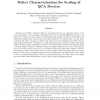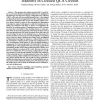20 search results - page 4 / 4 » Logic and Fault Simulation by Cellular Automata |
DFT
2005
IEEE
13 years 11 months ago
2005
IEEE
This paper analyzes the deposition defects in devices and circuits made of Quantum-dot Cellular Automata (QCA) for molecular implementation. Differently from metal-based QCA, in ...
MJ
2006
13 years 5 months ago
2006
This paper proposes a SPICE model development methodology for quantum-dot cellular automata (QCA) cells and presents a SPICE model for QCA cells. The model is validated by simulat...
DFT
2004
IEEE
13 years 9 months ago
2004
IEEE
Quantum dot Cellular Automata (QCA) is amongst promising new computing scheme in the nano-scale regimes. As an emerging technology, QCA relies on radically different operations in...
FCCM
1997
IEEE
13 years 9 months ago
1997
IEEE
We propose an FPGA chip architecture based on a conventional FPGA logic array core, in which I/O pins are clocked at a much higher rate than that of the logic array that they serv...
TVLSI
2008
13 years 5 months ago
2008
Abstract--The quantum-dot cellular automata (QCA) model offers a novel nano-domain computing architecture by mapping the intended logic onto the lowest energy configuration of a co...


